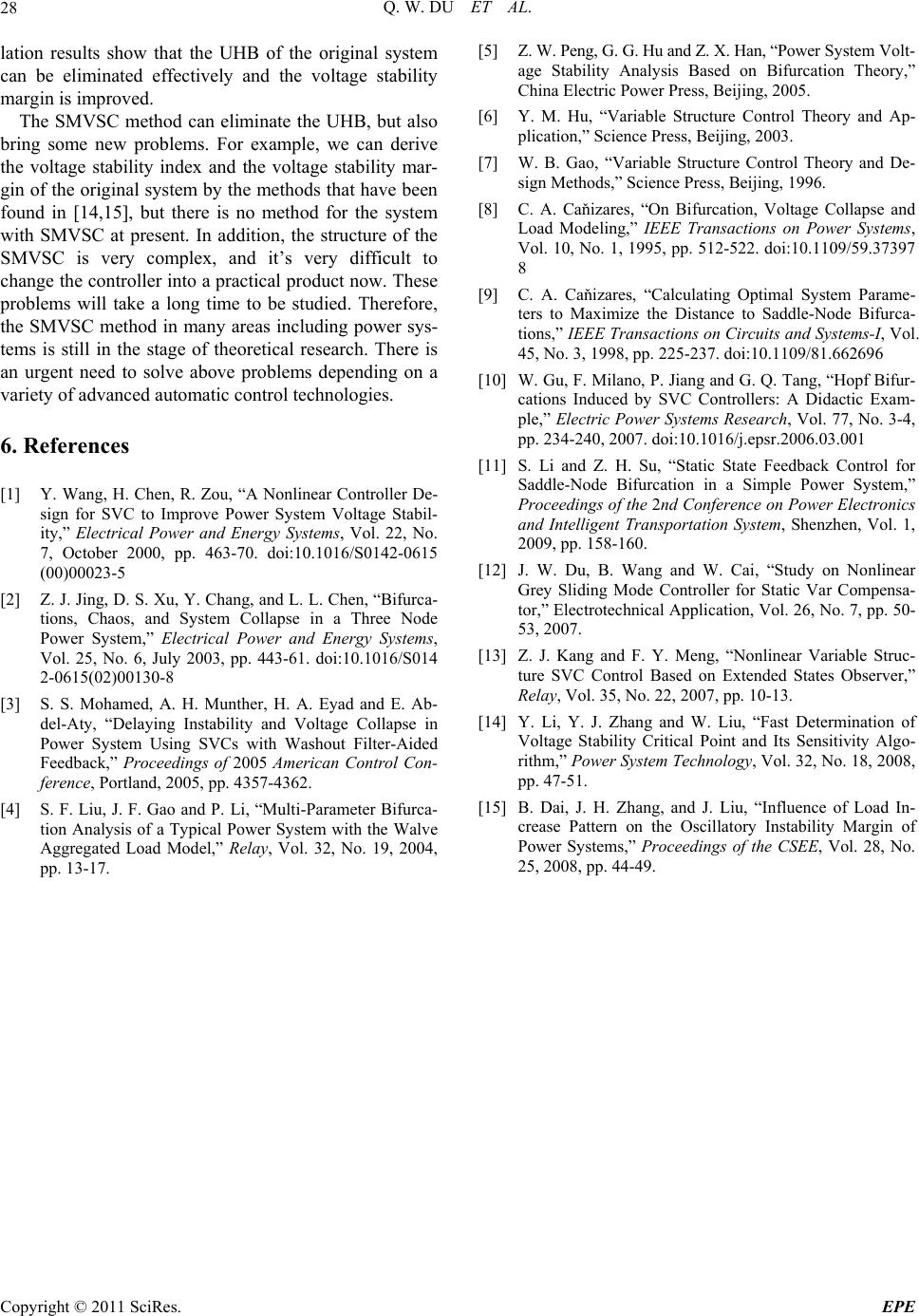
Q. W. DU ET AL.
Copyright © 2011 SciRes. EPE
28
lation results show that the UHB of the original system
can be eliminated effectively and the voltage stability
margin is improved.
The SMVSC method can eliminate the UHB, but also
bring some new problems. For example, we can derive
the voltage stability index and the voltage stability mar-
gin of the original system by the methods that have been
found in [14,15], but there is no method for the system
with SMVSC at present. In addition, the structure of the
SMVSC is very complex, and it’s very difficult to
change the controller into a practical product now. These
problems will take a long time to be studied. Therefore,
the SMVSC method in many areas including power sys-
tems is still in the stage of theoretical research. There is
an urgent need to solve above problems depending on a
variety of advanced automatic control technologies.
6. References
[1] Y. Wang, H. Chen, R. Zou, “A Nonlinear Controller De-
sign for SVC to Improve Power System Voltage Stabil-
ity,” Electrical Power and Energy Systems, Vol. 22, No.
7, October 2000, pp. 463-70. doi:10.1016/S0142-0615
(00)00023-5
[2] Z. J. Jing, D. S. Xu, Y. Chang, and L. L. Chen, “Bifurca-
tions, Chaos, and System Collapse in a Three Node
Power System,” Electrical Power and Energy Systems,
Vol. 25, No. 6, July 2003, pp. 443-61. doi:10.1016/S014
2-0615(02)00130-8
[3] S. S. Mohamed, A. H. Munther, H. A. Eyad and E. Ab-
del-Aty, “Delaying Instability and Voltage Collapse in
Power System Using SVCs with Washout Filter-Aided
Feedback,” Proceedings of 2005 American Control Con-
ference, Portland, 2005, pp. 4357-4362.
[4] S. F. Liu, J. F. Gao and P. Li, “Multi-Parameter Bifurca-
tion Analysis of a Typical Power System with the Walve
Aggregated Load Model,” Relay, Vol. 32, No. 19, 2004,
pp. 13-17.
[5] Z. W. Peng, G. G. Hu and Z. X. Han, “Power System Volt-
age Stability Analysis Based on Bifurcation Theory,”
China Electric Power Press, Beijing, 2005.
[6] Y. M. Hu, “Variable Structure Control Theory and Ap-
plication,” Science Press, Beijing, 2003.
[7] W. B. Gao, “Variable Structure Control Theory and De-
sign Methods,” Science Press, Beijing, 1996.
[8] C. A. Caňizares, “On Bifurcation, Voltage Collapse and
Load Modeling,” IEEE Transactions on Power Systems,
Vol. 10, No. 1, 1995, pp. 512-522. doi:10.1109/59.37397
8
[9] C. A. Caňizares, “Calculating Optimal System Parame-
ters to Maximize the Distance to Saddle-Node Bifurca-
tions,” IEEE Transactions on Circuits and Systems-I, Vol.
45, No. 3, 1998, pp. 225-237. doi:10.1109/81.662696
[10] W. Gu, F. Milano, P. Jiang and G. Q. Tang, “Hopf Bifur-
cations Induced by SVC Controllers: A Didactic Exam-
ple,” Electric Power Systems Research, Vol. 77, No. 3-4,
pp. 234-240, 2007. doi:10.1016/j.epsr.2006.03.001
[11] S. Li and Z. H. Su, “Static State Feedback Control for
Saddle-Node Bifurcation in a Simple Power System,”
Proceedings of the 2nd Conference on Power Electronics
and Intelligent Transportation System, Shenzhen, Vol. 1,
2009, pp. 158-160.
[12] J. W. Du, B. Wang and W. Cai, “Study on Nonlinear
Grey Sliding Mode Controller for Static Var Compensa-
tor,” Electrotechnical Application, Vol. 26, No. 7, pp. 50-
53, 2007.
[13] Z. J. Kang and F. Y. Meng, “Nonlinear Variable Struc-
ture SVC Control Based on Extended States Observer,”
Relay, Vol. 35, No. 22, 2007, pp. 10-13.
[14] Y. Li, Y. J. Zhang and W. Liu, “Fast Determination of
Voltage Stability Critical Point and Its Sensitivity Algo-
rithm,” Power System Technology, Vol. 32, No. 18, 2008,
pp. 47-51.
[15] B. Dai, J. H. Zhang, and J. Liu, “Influence of Load In-
crease Pattern on the Oscillatory Instability Margin of
Power Systems,” Proceedings of the CSEE, Vol. 28, No.
25, 2008, pp. 44-49.